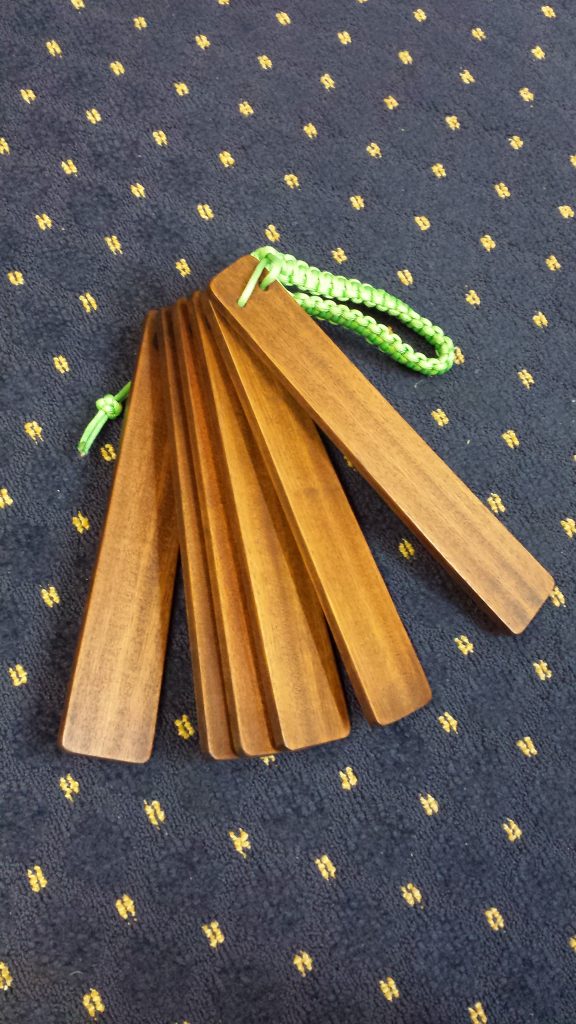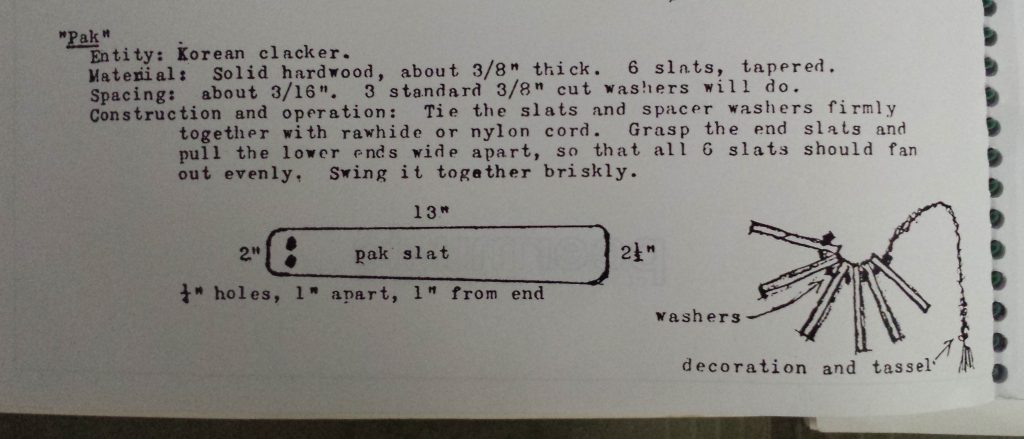Colin’s Corner: The Pak

Published December 7, 2017 by Third Coast Percussion | Share this post!
Welcome to Colin’s Corner! In this series of blog posts, our resident superhero and studio manager Colin Campbell will take you into his world of incredible craftsmanship to show off some of the instruments and works of art he creates for Third Coast.
Welcome to Colin’s Corner! In this series of blog posts, our resident superhero and studio manager Colin Campbell will take you into his world of incredible craftsmanship to show off some of the instruments and works of art he creates for Third Coast.
This summer, I was tasked with building/acquiring the special instruments required for Lou Harrison’s Concerto for Organ and Percussion Orchestra and Concerto for Violin and Percussion Orchestra.
The first instrument that I made for the Harrison concerti was the “Pak.”
Harrison gives the following notes in the score:
Entity: Korean clacker
Material: Solid hardwood, about 3/8” thick. 6 slats, tapered.
Spacing: about 3/16”. 3 standard 3/8” cut washers will do.
Construction and operation: Tie the slats and spacer washers firmly together with rawhide or nylon cord. Grasp the end slats and pull the lower ends wide apart, so that all 6 slats should fan out evenly. Swing it together briskly.
I chose to tackle the pak first because it seemed the simplest to construct. A Google image search turned up some useful pictures of traditional Korean examples. The only materials required were wood, cord, and washers. I made the pak from a single board of African mahogany. Mahogany is a prized hardwood for furniture, and has been used to make drum shells as well.
Making six identical pieces is easier said than done. The curved profile of all six slats needed to match exactly, and the holes for tying them together needed to be lined up. In traditional woodworking, I would have used a pattern flush-trim bit on a router, and trimmed the wood around the perimeter of a master template made from acrylic or MDF (medium-density fiberboard). But since I had recently acquired a CNC carving machine (Inventables X-Carve), I decided to create a digital template instead.
Luckily, Harrison gives dimensions for the slats in his sketch. Using a vector drawing program (Adobe Illustrator), I made a 2D drawing of the slat’s outline and two holes.
After a couple of test cuts, the CNC “computer numerical control” cutting went surprisingly smoothly. I crosscut each segment of the mahogany board to length, clamped it down to the machining bed, and the machine did the rest. I was able to produce six identical slats with relative speed and ease.
For most of my wood projects, especially pieces that are handled often, I prefer to sand down to 400-grit. It is only slightly more time-consuming, and I feel that the result is well worth it. Usually I don’t use stain, but in this case I wanted a rich, lustrous dark finish similar to the traditional Korean examples I had seen. I went with my favorite Java gel stain from General Finishes. Applied properly, it beautifully expresses the woodgrain, and adds a rich transparent color. Finally, I finished the slats with clear satin lacquer. This is the origin of the now world-famous phrase “put some lacquer on your clacker.”
I love learning to tie a new knot. There’s a unique satisfaction that comes from the first time you get it right. Come to think of it, the feeling is very similar to the first time one successfully pulls off a new sleight-of-hand move or drum rudiment. Luckily for me, there is a veritable army of 11-year-olds on YouTube who have mastered the art of paracord tying. I cannot stress what a valuable resource YouTube is for makers of any stripe. It is a wondrous and powerful tool for self-teaching. Although the decorative knots I used to make my pak are non-traditional, I think they still look attractive and appropriate for the application. Of course, I chose a “TCP Green” paracord. The two main knots used are the lanyard knot and cobra weave. Felt washers were used in between each slat as spacers.
That was about it for this one. I was, and still am, pretty happy with the end product. It sounds great– a loud, clear “C-C-C-C-CLACK!” If you don’t have access to mahogany, maple or ash would be a good substitute.



